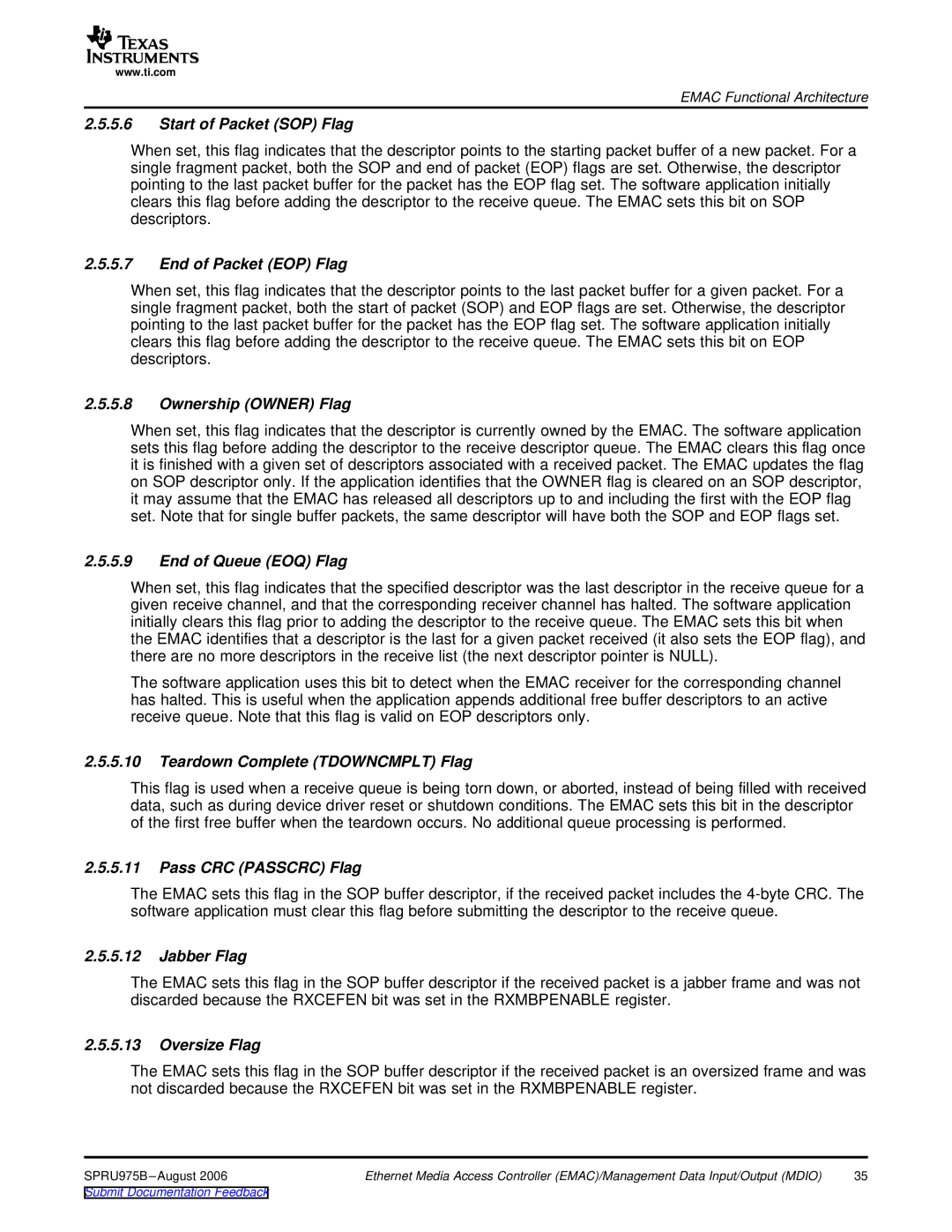
www.ti.com
EMAC Functional Architecture
2.5.5.6Start of Packet (SOP) Flag
When set, this flag indicates that the descriptor points to the starting packet buffer of a new packet. For a single fragment packet, both the SOP and end of packet (EOP) flags are set. Otherwise, the descriptor pointing to the last packet buffer for the packet has the EOP flag set. The software application initially clears this flag before adding the descriptor to the receive queue. The EMAC sets this bit on SOP descriptors.
2.5.5.7End of Packet (EOP) Flag
When set, this flag indicates that the descriptor points to the last packet buffer for a given packet. For a single fragment packet, both the start of packet (SOP) and EOP flags are set. Otherwise, the descriptor pointing to the last packet buffer for the packet has the EOP flag set. The software application initially clears this flag before adding the descriptor to the receive queue. The EMAC sets this bit on EOP descriptors.
2.5.5.8Ownership (OWNER) Flag
When set, this flag indicates that the descriptor is currently owned by the EMAC. The software application sets this flag before adding the descriptor to the receive descriptor queue. The EMAC clears this flag once it is finished with a given set of descriptors associated with a received packet. The EMAC updates the flag on SOP descriptor only. If the application identifies that the OWNER flag is cleared on an SOP descriptor, it may assume that the EMAC has released all descriptors up to and including the first with the EOP flag set. Note that for single buffer packets, the same descriptor will have both the SOP and EOP flags set.
2.5.5.9End of Queue (EOQ) Flag
When set, this flag indicates that the specified descriptor was the last descriptor in the receive queue for a given receive channel, and that the corresponding receiver channel has halted. The software application initially clears this flag prior to adding the descriptor to the receive queue. The EMAC sets this bit when the EMAC identifies that a descriptor is the last for a given packet received (it also sets the EOP flag), and there are no more descriptors in the receive list (the next descriptor pointer is NULL).
The software application uses this bit to detect when the EMAC receiver for the corresponding channel has halted. This is useful when the application appends additional free buffer descriptors to an active receive queue. Note that this flag is valid on EOP descriptors only.
2.5.5.10Teardown Complete (TDOWNCMPLT) Flag
This flag is used when a receive queue is being torn down, or aborted, instead of being filled with received data, such as during device driver reset or shutdown conditions. The EMAC sets this bit in the descriptor of the first free buffer when the teardown occurs. No additional queue processing is performed.
2.5.5.11Pass CRC (PASSCRC) Flag
The EMAC sets this flag in the SOP buffer descriptor, if the received packet includes the
2.5.5.12Jabber Flag
The EMAC sets this flag in the SOP buffer descriptor if the received packet is a jabber frame and was not discarded because the RXCEFEN bit was set in the RXMBPENABLE register.
2.5.5.13Oversize Flag
The EMAC sets this flag in the SOP buffer descriptor if the received packet is an oversized frame and was not discarded because the RXCEFEN bit was set in the RXMBPENABLE register.
SPRU975B | Ethernet Media Access Controller (EMAC)/Management Data Input/Output (MDIO) | 35 |
